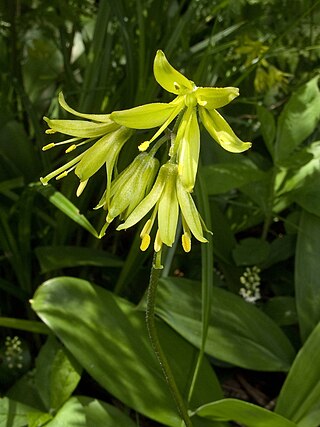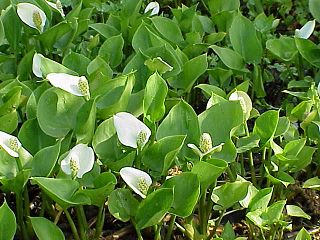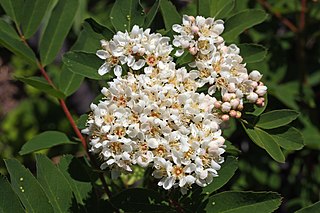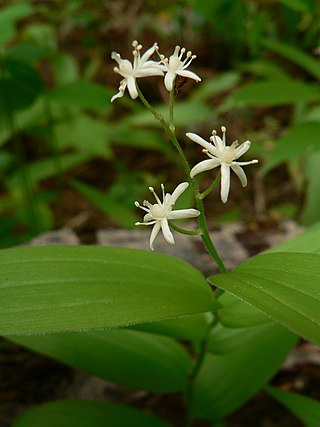
Clintonia is a genus of flowering plants in the lily family Liliaceae. Plants of the genus are distributed across the temperate regions of North America and eastern Asia, in the mesic understory of deciduous or coniferous forests. The genus, first described by Constantine Samuel Rafinesque in 1818, was named for DeWitt Clinton (1769–1828), a naturalist and politician from the U.S. state of New York. For this reason, plants of the genus are commonly known as Clinton's lily. The common name bluebead refer to the distinctive fruit of members of the genus. Since fruit color varies somewhat across species, the common name bead lily is used as well.

Actaea, commonly called baneberry, bugbane and cohosh, is a genus of flowering plants of the family Ranunculaceae, native to subtropical, temperate and subarctic regions of Europe, Asia and North America.

Linnaea borealis is a species of flowering plant in the family Caprifoliaceae. Until 2013, it was the only species in the genus Linnaea. It is a boreal to subarctic woodland subshrub, commonly known as twinflower.

Clintonia borealis is a species of flowering plant in the lily family Liliaceae. The specific epithet borealis means "of the north," which alludes to the fact that the species tends to thrive in the boreal forests of eastern Canada and northeastern United States.

Chugach State Park covers 495,204 acres covering a hilly region immediately east of Anchorage, in south-central Alaska.

Maianthemum dilatatum is a common rhizomatous perennial flowering plant that is native to western North America from northern California to the Aleutian islands, and Asia across the Kamchatka Peninsula, Japan, and Korea. It grows in coastal temperate rainforests, and is often the dominant groundcover plant in Sitka Spruce forests.

Maianthemum racemosum, the treacleberry, feathery false lily of the valley, false Solomon's seal, Solomon's plume or false spikenard, is a species of flowering plant native to North America. It is a common, widespread plant with numerous common names and synonyms, known from every US state except Hawaii, and from every Canadian province and territory, as well as from Mexico.

Calla is a genus of flowering plant in the family Araceae, containing the single species Calla palustris.

Actaea spicata, the baneberry or herb Christopher, is a species of flowering plant in the genus Actaea, native from Europe to western Siberia and northern Iran. It is often found on limestone edges and in deciduous woodland; key factors are shade, low competition, and a cool, protected root run.

Actaea pachypoda, the white baneberry or doll's-eyes, is a species of flowering plant in the genus Actaea, of the family Ranunculaceae.

Actaea rubra, the red baneberry or chinaberry, is a poisonous herbaceous flowering plant in the family Ranunculaceae, native to North America.

Sorbus sitchensis, commonly known as western mountain ash and Sitka mountain-ash, is a small species of shrub of north-western North America.

Clintonia uniflora, commonly known as bride's bonnet, queen's cup, or bead lily, is a species of flowering plant in the lily family Liliaceae. The specific epithet uniflora means "one-flowered", a characteristic that distinguishes this species from others in the genus Clintonia. For this reason, it is also known as the single-flowered clintonia.

Maianthemum stellatum is a species of flowering plant, native across North America. It has been found in northern Mexico, every Canadian province and territory except Nunavut, and every US state except Hawaii and the states of the Southeast. It has little white buds in the spring, followed by delicate starry flowers, then green-and-black striped berries, and finally deep red berries in the fall.

Cypripedium passerinum is a species of lady's slipper orchid known by the common names sparrow's-egg lady's-slipper, spotted lady's-slipper, and Franklin's lady's-slipper.

Actaea elata is a species of flowering plant in the buttercup family known by the common name tall bugbane. It is native to the Pacific Northwest of North America, where it can be found in British Columbia, Washington, and Oregon.

Actaea matsumurae, the Kamchatka bugbane or Japanese bugbane, is a species of flowering plant in the buttercup family Ranunculaceae, that is native to Japan, Mongolia and Eastern Russia. Other common names include baneberry, which is also applied to other Actaea species.

The Alaska Native Plant Society (AKNPS) is a non-profit organization focused on studying and conserving Alaska's native plant species. The organization was started in 1982 by Verna Pratt and a group of amateur botanists with the goal to study, conserve, and educate. Their mission is to conserve and study Alaskan native plants in their natural habitats, and to educate in order to increase understanding and appreciation of native plants.




















